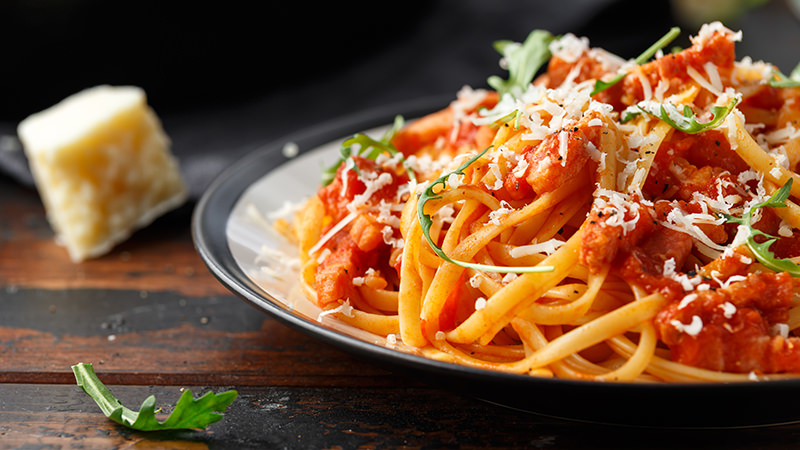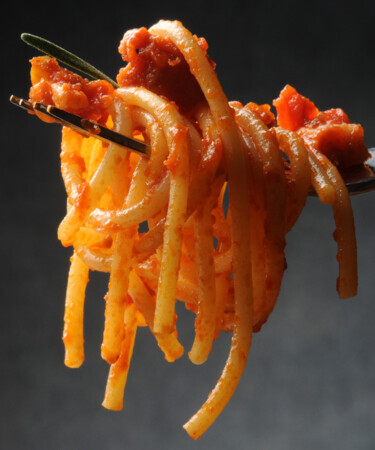
Growing up, I always wished I were Italian. Don’t misunderstand me; I love my German heritage, but there was always a little part of me that was envious of my friends’ lilting last names, multi-course Christmas Eve dinners, and brash yet lovable family members. But the real reason that I longed to live la dolce vita, of course, was the sauce. Oh, how I dreamed of having a proprietary family red sauce to cherish, the recipe never written down, but instead passed down from generation to generation over years of Sunday suppers, gathered in the kitchen. I still try to finagle these sauce secrets, slipping the topic casually into conversation from time to time; I’ve yet to succeed.
Since I wasn’t going to inherit a red sauce, I set my sights instead to mastering the classics on my own. Happily, the Italians have shared with the world their plethora of simple, flavorful sauces, to the point that those of us without even a speck of Italian blood in our veins grow up knowing the terms Bolognese, Carbonara, and Alfredo. But there is another classic, a recent discovery for me, that everyone must add to their repertoire immediately. It is so easy and delicious and yet utterly unforgettable. I speak of the spicy, savory Amatriciana.
While most think of sugo all’amatriciana as a staple of Roman cooking, the dish actually originated about 90 miles northeast of Rome in a historic hilltop town called Amatrice tucked away in the mountains. While the exact history of the town’s namesake sauce has many tales, there are a few things that are generally agreed upon. First of all, like most classic Italian dishes, Amatriciana is based on the ingredients that were available locally: cured pork cheek (a richer, higher-quality bacon) called”guanciale,” and pecorino, Amatrice’s hard, salty sheep’s-milk cheese. However, this wasn’t a dish of nobility; it was a dish of peasants, who typically couldn’t afford herbs, garlic, or luxurious spices. Thus, Amatriciana depends on pepper for its spice, in the form of both black pepper and chili pepper.

Even tomatoes were not always involved in the making of Amatriciana; the sauce’s predecessor, Gricia, is a simple combination of guanciale, pecorino, and black pepper. Sometime during the 19th and 20th centuries (yes, accounts vary that much), while Amatriciana was becoming famous in Rome, the recipe started involving San Marzano tomatoes as well. As for the choice of pasta, the traditionalists of Amatrice use spaghetti, creating the dish spaghetti all’amatriciana. In Rome, bucatini became popular, hence the prevalence of bucatini all’amatriciana in many a trattoria. Some have even adapted the sauce into a pizza version, using only classic ingredients.
It’s more important now than ever before that the history of Amatriciana is remembered. On Aug. 24 of this year, just before the 50th anniversary of the town’s annual festival celebrating Amatriciana, a devastating earthquake hit Amatrice. The town, comprised of historic stone structures built mostly from local river rocks over the centuries, lies almost completely in ruins, with 300 people killed and nearly all residents displaced and uncertain of whether they will ever return. In the aftermath of the earthquake, chefs around the world began cooking Amatriciana dishes and donating the proceeds to relief efforts. But even in cooking and adopting this classic as your own, you too can preserve the history of Amatrice and help Amatriciana endure.
When it comes to preparing pasta all’amatriciana, remember: Simple is better. There are many opinions about ingredients when it comes to preparing the dish today, and many chefs choose to add onion or garlic. However, the mayor of Amatrice emphatically states that this is not traditional, favoring only guanciale, pecorino, white wine, black pepper, chili pepper, and San Marzano tomatoes. It’s safe to say that he knows best!
Recipe: Pasta all’amatriciana
Ingredients:
- 1 tablespoon extra virgin olive oil
- 6 oz. guanciale (pancetta or, in a pinch, bacon will do), cut into ½-inch cubes
- Pinch of red pepper flakes
- ¼ cup dry white wine (optional)
- 1 28-oz. can whole peeled San Marzano tomatoes, crushed by hand
- Pinch of freshly ground black pepper
- Salt
- 1 lb. dried spaghetti or bucatini pasta
- ¼ cup freshly grated Pecorino (or Parmesan), plus additional for serving, if desired
Directions:
- Heat olive oil in a large skillet over medium heat. Sauté guanciale and red pepper flakes until lightly browned, 4-5 minutes.
- If using, add wine, scraping the bottom of the pan to gather any browned bits until wine is nearly all evaporated, about 3 minutes.
- Add tomatoes and bring to a simmer. Add black pepper; reduce heat to low and simmer 15-20 minutes, stirring occasionally, until sauce thickens.
- While sauce is simmering, bring a large pot of salted water to boil. Boil pasta until just shy of al dente (1-2 minutes less than the package recommends). Using tongs, transfer cooked pasta and about ¼ cup of pasta water to sauce, stirring quickly until incorporated. If the sauce is too thick, add a bit more of the pasta water.
- Remove from heat and stir in cheese. Season to taste with salt and pepper and serve.
Wine pairing: Keep it local and look for a central Italian red to complement the bite of the tomato and spice: Cesanese del Piglio from Lazio, Montepulciano d’Abruzzo from Abruzzo, or Chianti Classico from Tuscany.
